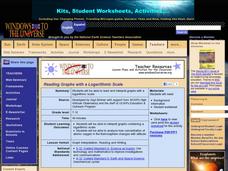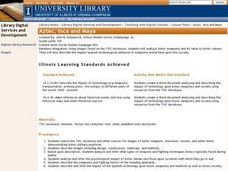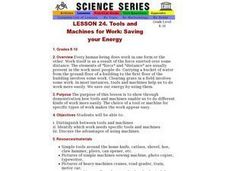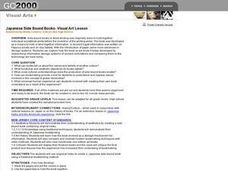Curated OER
Art On Trial (A Mock-Court Activity)
Students engage in a mock trial to decide if a work of prospective public art is "art" and accepted for a city park. They broaden their definitions of what "art" is. Students distinguish between opinion and informed judgment of art works.
Curated OER
Science: Fossil of a Carbonized Plant
Students classify leaves by shape and margins and use them to create models of plant fossils. By using paper over a leaf, they simulate fossilization of organisms onto sedimentary rocks. Following instructions on worksheets, students...
Curated OER
Ratifying the Constitution
After a lecture on ratifying the Constitution, this worksheet would be perfect to reinforce your government (or U.S. History) learners' new knowledge. The activity contains ten knowledge-level and comprehension-level questions. This...
Curated OER
Reading Graphs with a Logarithmic Scale
Guide high school meteorologists through a detailed examination of oxygen concentration data. The learners analyze a line graph containing logarithmic data and employ the use of a graphing calculator. A comprehensive worksheet and links...
Curated OER
Literacy Lesson: Guided Reading
Here is a wonderful lesson designed for students with special needs. This well-thought-out lesson uses Big Books, familiar stories, and has a lot of review learning built into it. The book, The Keeping Quilt is used in the main part of...
Curated OER
Personal Narrative Paragraphs: Class Quilt
Begin this activity by asking third graders to bring from home pieces of cloth that represent something important to them. (Have extras for students who need them.) They reflect on important events in their lives, compose narrative...
Curated OER
How to Write an Essay: Secondary ed.
Whether introducing the structure of expository essays or reviewing the format with your high schoolers, take the time to check out this resource. Examples of seven common forms of introductory paragraphs and six types of conclusions, as...
Curated OER
Ancient China
Students research different dynasties that existed in China around different themes. They chart each dynasty for written assessment. Each chart has details that chronicles the gathered information.
Curated OER
You Gotta Have A Hat
First graders compare versions of the folktale, 'Caps for Sale.' After listening to both stories, 1st graders utilize a Venn Diagram imbedded in this lesson plan to produce a graphic organizer detailing the similarities and differences...
Curated OER
CyberHunt: Ancient China
Students participate in various web based activities about ancient China in order to discover the accomplishments of this extraordinary culture. In this history lesson, students explore the Chinese paper making recipes, and the special...
Curated OER
Understanding Narrative Poetry
In this poetry worksheet, students learn about narrative poetry. They then answer 7 questions about one of the poems they read, practice writing their own narrative poem, and complete a research project using the internet. The answers...
Curated OER
Before, During, & After
In this time line worksheet, students determine at what point in the Medieval Era given events happened. Students list these events in the appropriate columns.
Curated OER
The Renaissance was a Rebirth
For this Renaissance study guide worksheet, students read a brief overview pertaining to the time period in world history and then respond to 4 reflection questions.
Curated OER
Inventing and Presenting Unit 3: Persuasive Speaking and Invention Promotion
Students write a proposal for a speech. Students prepare appropriate visuals for use in the proposed speech. Students produce one or more graphs that summarize the results from the experimentation. Students deliver an effective speech in...
Curated OER
Looking At Science And Technology From a Human Rights Perspective
Students answer discussion questions and analyze technological innovations, scientific discoveries, and environmental crises from a human rights perspective. They research and report back to the class about a related topic.
Curated OER
Africa Puzzle
In this geography worksheet, students complete a crossword puzzle about Africa. They identify the capitals of various countries located in Africa, the most fertile area, the largest desert, and the longest river. There are 19 questions...
Curated OER
Bronze Age Ship in 2004
In this geography worksheet, students read an excerpt about a ship from the Bronze Age. They identify and name countries that the ancient Minoan sea travelers traded with and what they exchanged. Then students examine the drawing and...
Curated OER
What Does 'Post Racial' Mean, Anyway?
Eighth graders explore where they personally stand on a post-election continuum, spanning from euphoria to despair. In this American History lesson, 8th graders read and discuss an article immediately following the election and a...
Curated OER
Aztec, Inca, and Maya
Seventh graders use images of Aztec weaponry to analyze its' value. They create a Word Document with the information.
Curated OER
Tools and Machines for Work: Saving your Energy
Students consider how tools and machines can make work easier. They examine specific tools for making work easier.
Curated OER
Japanese Side Bound Books
Students create Japanese side-bound books using traditional bookbinding methods and original Haikus in this Art instructional activity for the High School classroom. The instructional activity can be modified for any grade level and can...
Curated OER
Basics of the Korean War
Students research the key players and major events of the Korean War. Students assigned in groups, research a country involved in the Korean War. Groups then bring their information to the whole groups to explain their country's...
Curated OER
Europe Puzzle
For this geography worksheet, students complete a crossword puzzle in reference to the geography of Europe. They identify the capital cities of various countries and the bodies of water which surround specific countries of Europe.
Curated OER
Developing a Paragraph
In this paragraph worksheet, learners read about the 3 parts of a paragraph, then cut out sentence strips and put them together, forming a topic sentence, details, and conclusion.























